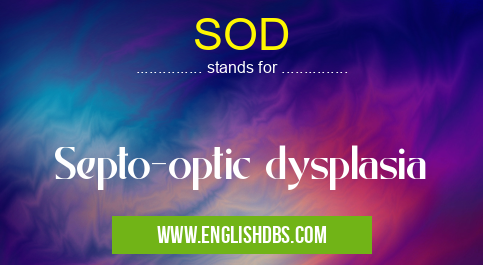What does SOD mean in VETERINARY
Septo-optic dysplasia (SOD) is a rare congenital disorder characterized by abnormalities in the development of the brain and eyes. It is caused by a disruption in the formation of the optic nerves and septum pellucidum, a thin membrane that separates the right and left ventricles in the brain.

SOD meaning in Veterinary in Medical
SOD mostly used in an acronym Veterinary in Category Medical that means Septo-optic dysplasia
Shorthand: SOD,
Full Form: Septo-optic dysplasia
For more information of "Septo-optic dysplasia", see the section below.
» Medical » Veterinary
Causes
The exact cause of SOD is unknown, but it is believed to be a combination of genetic and environmental factors. Some risk factors include:
- Maternal diabetes
- Genetic mutations
- Exposure to certain toxins during pregnancy
Symptoms
The symptoms of SOD can vary depending on the severity of the disorder. Common signs and symptoms include:
- Visual impairment: Nystagmus (involuntary eye movements), strabismus (crossed eyes), or blindness
- Hormonal deficiencies: Growth hormone deficiency, thyroid hormone deficiency, or adrenal insufficiency
- Intellectual disability: Learning difficulties, developmental delays
- Seizures
- Behavioral problems: Hyperactivity, attention deficit disorder
- Other physical features: Cleft lip or palate, hearing loss, kidney abnormalities
Diagnosis
SOD is diagnosed through a combination of physical examination, imaging studies (such as MRI or CT scans), and genetic testing. A detailed history and family history can also provide important clues.
Treatment
There is no cure for SOD, but treatment can help manage the symptoms and improve quality of life. Treatment may include:
- Surgery to correct eye problems
- Hormone replacement therapy
- Anticonvulsant medications to control seizures
- Special education and support services
Prognosis
The prognosis for SOD varies depending on the severity of the disorder. Some individuals may have mild symptoms that do not require significant treatment, while others may experience severe disabilities that require ongoing medical care and support. With early diagnosis and appropriate treatment, most individuals with SOD can live full and productive lives.
Essential Questions and Answers on Septo-optic dysplasia in "MEDICAL»VET"
What is septo-optic dysplasia (SOD)?
Septo-optic dysplasia (SOD) is a rare congenital disorder characterized by abnormalities of the brain's midline structures, including the optic nerves, pituitary gland, and septum pellucidum. It is caused by disruptions during early embryonic development and can range in severity.
What are the symptoms of SOD?
Symptoms of SOD can vary depending on the severity of the condition and may include visual impairments, hormonal imbalances, developmental delays, and seizures. Visual problems such as nystagmus, optic nerve hypoplasia, and strabismus are common, as are growth hormone and thyroid hormone deficiencies.
What causes SOD?
The exact cause of SOD is unknown, but genetic mutations and environmental factors are thought to play a role. Mutations in genes such as HESX1, SOX2, and FOXG1 have been linked to the development of SOD.
How is SOD diagnosed?
SOD is typically diagnosed through a combination of physical examinations, imaging tests, and genetic testing. Magnetic resonance imaging (MRI) scans can reveal abnormalities in the brain's midline structures, while genetic testing can identify potential genetic mutations associated with SOD.
What is the treatment for SOD?
Treatment for SOD focuses on managing the specific symptoms and addressing any underlying hormonal imbalances. Visual impairments may require corrective lenses or surgery, while hormone replacement therapy can be used to treat growth hormone or thyroid hormone deficiencies. Early intervention and specialized care are essential for improving outcomes.
What is the prognosis for individuals with SOD?
The prognosis for individuals with SOD varies depending on the severity of the condition. With appropriate treatment, many individuals with milder forms of SOD can live full and independent lives. However, more severe cases may require ongoing medical support and specialized care.
Final Words: Septo-optic dysplasia is a complex and challenging disorder that affects both physical and cognitive function. It is important to diagnose and treat SOD early to minimize symptoms and improve outcomes. Ongoing research is focused on understanding the causes of SOD and developing new treatments to help individuals with this condition.
SOD also stands for: |
|
| All stands for SOD |
